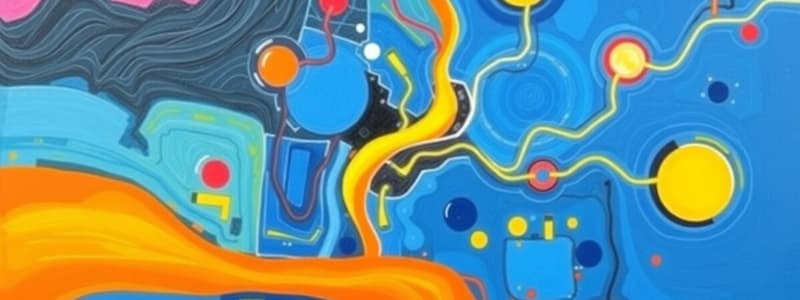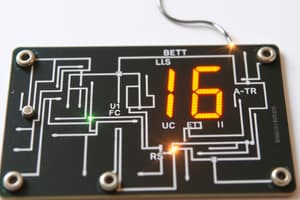Podcast
Questions and Answers
What is the definition of current?
What is the definition of current?
- The rate of flow of charge across a cross-section normal to the direction of flow (correct)
- The total charge in a specific time
- The amount of positive ions in a conductor
- The flow of electrons in a circuit
Conventional current flows in the same direction as the flow of electrons.
Conventional current flows in the same direction as the flow of electrons.
False (B)
What is the electronic charge of one electron?
What is the electronic charge of one electron?
1.6 × 10^-19 coulomb
The unit of current is defined as the unit of charge divided by the unit of ______.
The unit of current is defined as the unit of charge divided by the unit of ______.
Match the types of currents with their descriptions:
Match the types of currents with their descriptions:
What is the definition of direct current (d.c.)?
What is the definition of direct current (d.c.)?
A secondary cell provides current as a result of reversible chemical reactions.
A secondary cell provides current as a result of reversible chemical reactions.
What are the main components of a cell that generate electrical energy?
What are the main components of a cell that generate electrical energy?
In a simple electric circuit, the current flows from the positive terminal of the cell to the ______ terminal.
In a simple electric circuit, the current flows from the positive terminal of the cell to the ______ terminal.
Match the following types of cells with their characteristics:
Match the following types of cells with their characteristics:
Flashcards
Direct Current (DC)
Direct Current (DC)
A steady flow of electric charges in one direction through a conductor.
Cell
Cell
A device that converts chemical energy into electrical energy.
Cell Terminals
Cell Terminals
The positive terminal of a cell releases electric charge, while the negative terminal receives it.
Primary Cells
Primary Cells
Signup and view all the flashcards
Secondary Cells (Accumulators)
Secondary Cells (Accumulators)
Signup and view all the flashcards
Electric Current
Electric Current
Signup and view all the flashcards
Electron Flow
Electron Flow
Signup and view all the flashcards
Conventional Current
Conventional Current
Signup and view all the flashcards
Magnitude of Current
Magnitude of Current
Signup and view all the flashcards
Current Flow in Electrolytes
Current Flow in Electrolytes
Signup and view all the flashcards
Study Notes
Current Electricity
- Current is the rate of flow of electric charge
- Current is measured in amperes (A)
- Current flows from positive to negative terminal
- Sources of direct current (DC) are cells and accumulators
- Primary cells provide current through irreversible chemical reactions, and cannot be recharged
- Secondary cells (or accumulators) provide current through a reversible chemical reaction, and can be recharged
- Conductors allow current to flow easily
- Insulators do not allow current to flow easily
- Ohm's law states that current is directly proportional to voltage and inversely proportional to resistance (V = IR)
- Resistance is measured in ohms (Ω)
- Different types of components in circuit diagrams are discussed, including cells/batteries, switches, ammeters, voltmeters, wires and loads.
- Different components are connected in series or parallel.
- Simple circuits are those with a cell, bulb, and switch to demonstrate basic current flow principles
Efficient Use of Energy
- Efficient use of energy involves reducing energy consumption to decrease cost and environmental impact
- Proper insulation in homes reduces heating/cooling needs
- Using fluorescent and LED lights reduces energy needed for illumination compared to incandescent bulbs
- Eco-friendly technologies are more efficient and less polluting
- Buildings can be designed to optimize use of natural light and reduce need for artificial lighting
- Using advanced boilers/furnaces in industries reduces energy needed for high temperatures
- Improving energy efficiency in buildings, industries, and transport reduces worldwide energy need and emission of greenhouse gases.
- Public awareness campaigns and community participation are important for more sensitive use of energy resources
Studying That Suits You
Use AI to generate personalized quizzes and flashcards to suit your learning preferences.



